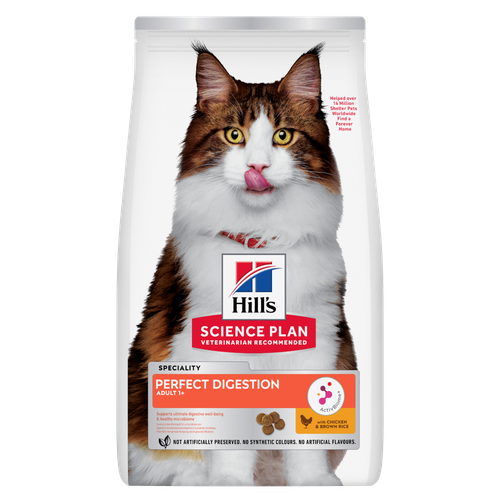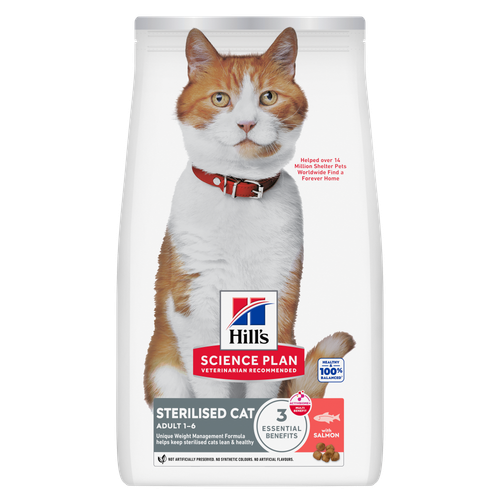
-
Find the right food for your petTake this quiz to see which food may be the best for your furry friend.Find the right food for your petTake this quiz to see which food may be the best for your furry friend.Featured products
 Adult Wet Dog Food with Beef
Adult Wet Dog Food with BeefHill's Science Plan Adult Multipack Wet Dog Food with Chicken, Beef & Turkey are complete premium pet foods for adult dogs from 1 year. Your dog will love these deliciously smooth and savoury minced loaves, formulated for balanced nutrition and overall health.
Shop Now Mature Adult Dog Food
Mature Adult Dog FoodHill's Science Plan Mature Adult Multipack Wet Dog Food with Chicken & Beef are complete premium pet foods for mature adult dogs from 7 years. Your dog will love these deliciously smooth and savoury minced loaves, formulated to deliver the appropriate amount of energy to support the needs of adult dogs.
Shop Now Puppy Food
Puppy FoodHill's Science Plan Puppy Multipack Wet Dog Food with Chicken & Beef are complete premium pet foods for growing puppies from weaning until 1 year old and for pregnant and nursing dogs. Your puppy will love these deliciously smooth and savoury minced loaves, formulated for balanced nutrition and overall health.
Shop NowFeatured products Light Adult Multipack Wet Cat Food with Chicken & Ocean Fish
Light Adult Multipack Wet Cat Food with Chicken & Ocean FishTender chicken chunks in gravy for cats, with L-carnitine and fewer calories for ideal weight management. Packed with high-quality protein, omega-6s, and vitamin E for shiny fur and healthy skin.
Shop Now Adult Multipack Wet Cat Food with Beef, Ocean Fish & Chicken
Adult Multipack Wet Cat Food with Beef, Ocean Fish & ChickenTender chunks in gravy for cats, with high-quality protein to maintain lean muscle. With vitamin E and omega-3s & -6s for healthy skin and balanced minerals to support healthy vital organs.
Shop Now Mature Adult Wet Cat Food with Chicken
Mature Adult Wet Cat Food with Chicken
Tender chicken chunks in gravy for mature adult cats. Made with easy-to-digest ingredients, high-quality protein for lean muscle maintenance and antioxidant vitamins C+E for optimal health.
Shop Now -
Dog
- Dog Tips & Articles
-
Health Category
- Weight
- Food & Environmental Sensitivities
- Urinary
- Digestive
- Joint
- Kidney
-
Life Stage
- Puppy Nutrition
- Adult Nutrition
- Senior Nutrition
Cat- Cat Tips & Articles
-
Health Category
- Weight
- Skin & Food Sensitivities
- Urinary
- Digestive
- Kidney
-
Life Stage
- Kitten Nutrition
- Adult Nutrition
Featured articles The Right Diet For Your Pet
The Right Diet For Your PetIn people, the right diet is very important. If you are eating the wrong way for your metabolism, activity level, age and lifestyle you could end up with health issues.
Read More Show some love with wet foods: a great choice for pets with health issues
Show some love with wet foods: a great choice for pets with health issuesShow some love with wet foods: a great choice for pets with health issues.
Read More The Incredible Science Behind Your Pet's Microbiome
The Incredible Science Behind Your Pet's MicrobiomeLearn what your pet's microbiome is, how it contributes to your pet's gut and overall health, and why nutrition is important in maintaining healthy microbiomes.
Read More -


High-fibre cat food has become a staple for cats with certain gastrointestinal issues. But why exactly is fibre important for your cat? In plenty of cases, cat food includes fibre to help with digestive functions and benefit the stool quality of cats who might otherwise have indigestion. High-fibre foods may be beneficial in cases of constipation, diarrhoea, diabetes and obesity.
The benefit of fibre in feeding the microbiome
The gut microbiome refers to the many millions of microorganisms (bacteria, protozoa, fungi, viruses) that live inside the digestive systems of cats (as well as dogs, humans and other living creatures).
This ecosystem of living organisms is fundamental to digestion. Bacteria in the colon of cats help to break down indigestible material to produce beneficial compounds like vitamins. Nowhere is the former function more evident than when it comes to breaking down fibre. Bacteria often engage with fibres in a process called fermentation.
Cats, even though they are carnivores, can benefit significantly from being fed a cat food with fibre.

The two types of fibre in cat food
One way to classify dietary fibre is based on solubility, namely soluble and insoluble fibres. Soluble fibres tend to dissolve in gastric juices and water in the gut, with some soluble fibres turning into gels that can hold water and make stools easier to pass. Insoluble fibres add bulk to the food eaten to help to regulate the transit of foodstuff through the intestines and can help with stool consistency. Both soluble and insoluble fibres can be fermentable, however soluble fibres tend to be more easily broken down (fermented). This means that bacteria in the gut can break down these fibres and produce new compounds that can, for example, nourish the cells of the colon.
Prebiotics in Cat Food With Fibre
Cat food with fibre typically includes a blend of soluble and insoluble fibres to help promote a healthy gut and good stool quality. Some of these fibre ingredients are also referred to as prebiotics, which are typically fermentable fibres that promote the growth of the "good bacteria" that live in the intestines. Some high-fibre cat foods work specifically because they help feed the beneficial bacteria and promote a balanced microbiome. The bacteria that live in the intestines form a large part of the gut microbiome. They ferment and digest fibres that humans and animals can’t break down themselves. This process produces fatty acids that help nourish the cells of the colon and keep them healthy. Prebiotics nourish these bacteria and this has many benefits. It keeps unwanted bacteria from multiplying because the ‘good bacteria’ stay in high numbers, the immune system is bolstered and it can help with things like inflammatory bowel disease, and may even have general health benefits. For example, research in people has shown a positive effect of prebiotics on mental and skin health. Plenty of digestive conditions may cause a bacterial imbalance including chronic diarrhoea, colitis and constipation.


Tasty Tips
Other reasons to feed a cat high-fibre food
Diabetic cats are typically fed high-protein, low-carbohydrate foods, but may also benefit from high-fibre cat food if they are prone to becoming overweight or have certain types of gastrointestinal conditions.
Some fibres slow the absorption of nutrients, allowing the sugars from starches to be absorbed more slowly and therefore stabilising blood sugar levels. Overweight cats or those prone to weight gain may also benefit from food high in fibre, as it may make them feel more full than regular food — and weight loss may help manage diabetes.
Furthermore, cat food with fibre may also help cats who suffer from gastrointestinal diseases that affect the large intestine and also small bowel diarrhoea. Fibre can help regulate the motility in the gastrointestinal tract and manage water balance to avoid the two extremes: constipation and diarrhoea. Molecules called long-chain fatty acids may be derived from the breakdown of fibre to help nourish the colon.
Is high-fibre cat food necessary for cats?
Left to their own devices, cats eat plenty of things humans consider indigestible, like hair, bone, gristle, feathers, fish scales and stomach contents of their prey. Gross, but natural. Some of these are digestible to a point, while others may contain fibre that is useful for digestion.
While there's a lot about cat nutrition that scientists have yet to understand, they're starting to realise that carnivorous cats can actually benefit from fibre. A study on cheetahs' eating habits published by the Journal of Animal Science found that those who ate whole prey — fur, stomach contents and all — had a more favourable faecal profile than those who ate simple meat. This has led researchers to conclude that carnivore digestive systems must do something useful with all that extra roughage.
The Role of Low-Fibre Cat Food
What if your vet recommends a low-fibre cat food instead? Typically, veterinarians recommend low-fibre food for cats with a sudden onset of gastrointestinal upset such as acute vomiting, diarrhoea or megacolon (a condition where the colon dilates abnormally). These foods tend to have higher levels of other nutrients such as electrolytes and B vitamins to help recovery in these cats. Always consult a veterinarian when selecting a food for your cat. If your cat is on a high-fibre meal plan, their vet should monitor them to make sure their fibre-responsive conditions are well managed.


Dr. Patty Khuly is an award-winning veterinarian known for her independent thinking, her spirited pet advocacy, her passion for the veterinary profession, and her famously irreverent pet health writing.
Dr. K is an honors graduate of both Wellesley College and the University of Pennsylvania School of Veterinary Medicine. She received her MBA at The Wharton School of Business as part of the prestigious VMD/MBA dual-degree program. She now owns Sunset Animal Clinic, a veterinary practice in Miami, Florida.
Related products

Hill's Science Plan Perfect Digestion Cat Food with Chicken & Brown Rice nourishes your cat's unique microbiome and helps them reach their full potential.

Hill's Science Plan Adult Sterilised Cat Dry Food with Salmon is specially formulated with ActivBiome+ Multi-Benefit Technology. It is a precisely balanced nutrition, tailored to meet the needs of sterilised cats, to help keep them lean & healthy.

Hill's Science Plan Sensitive Stomach & Skin Adult Wet Cat Food with Turkey is a complete pet food for adult cats, aged 1–6 years. This highly digestible wet food comes in a pouch and supports healthy digestion, as well as nourishes skin and promotes a thick and lustrous coat.

Hill's Science Plan Hairball & Perfect Coat Adult Cat Food with Chicken is formulated to effectively help avoid hairball formation in adult cats while promoting a beautiful coat. Thanks to its mix of essential omega-6 fatty acids, this food benefits the cat's skin and fur, keeping them healthy and shiny. Our Advanced Fibre Technology helps reduce hairballs by naturally promoting their passage through the gut. This food is formulated with high-quality protein for a perfectly balanced, great-tasting recipe.
Related articles

Chocolate is known to be poisonous for dogs, but it can also be toxic for cats. Learn why chocolate is bad for cats & what to do if she's eaten it.

Learn how to make homemade cat treats that are healthy for your pet with this recipe from Hills Pet Nutrition.

There are three common ways to feed a cat. Each way has its advantages and disadvantages.

From essential vitamins & minerals to different types of meat, learn what to look for when choosing the best cat food for your feline.

Put your cat on a diet without them knowing
Our low calorie formula helps you control your cat's weight. It's packed with high-quality protein for building lean muscles, and made with purposeful ingredients for a flavourful, nutritious meal. Clinically proven antioxidants, Vitamin C+E, help promote a healthy immune system.
Put your cat on a diet without them knowing
Our low calorie formula helps you control your cat's weight. It's packed with high-quality protein for building lean muscles, and made with purposeful ingredients for a flavourful, nutritious meal. Clinically proven antioxidants, Vitamin C+E, help promote a healthy immune system.

